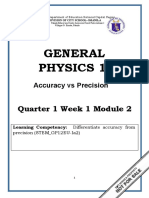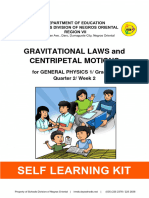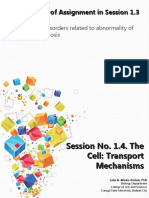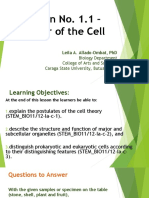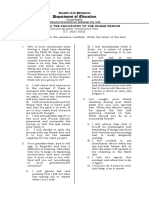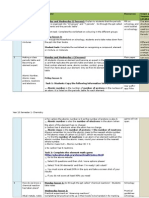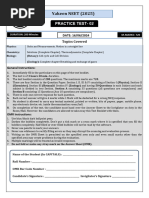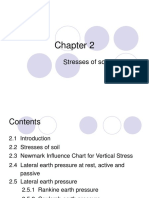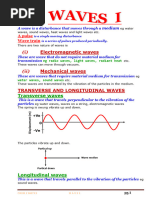Weekly Learning Activity Sheets General Physics 1 Grade 12, Quarter 2, Week 5
Weekly Learning Activity Sheets General Physics 1 Grade 12, Quarter 2, Week 5
Uploaded by
Shekaina Faith Cuizon LozadaCopyright:
Available Formats
Weekly Learning Activity Sheets General Physics 1 Grade 12, Quarter 2, Week 5
Weekly Learning Activity Sheets General Physics 1 Grade 12, Quarter 2, Week 5
Uploaded by
Shekaina Faith Cuizon LozadaOriginal Description:
Original Title
Copyright
Available Formats
Share this document
Did you find this document useful?
Is this content inappropriate?
Copyright:
Available Formats
Weekly Learning Activity Sheets General Physics 1 Grade 12, Quarter 2, Week 5
Weekly Learning Activity Sheets General Physics 1 Grade 12, Quarter 2, Week 5
Uploaded by
Shekaina Faith Cuizon LozadaCopyright:
Available Formats
WEEKLY LEARNING ACTIVITY SHEETS
GENERAL PHYSICS 1 GRADE 12, QUARTER 2, WEEK 5
FLUID MECHANICS
Name:_____________________________________ Section: ____________________
Learning Objectives
- Relate density, specific gravity, mass and volume to each other.
(STEM_GP12FM-IIf-40)
- Relate pressure to area and force. (STEM_GP12FM-IIf-41)
- Relate pressure to fluid density and depth. (STEM_GP12FM-IIf-42)
- Apply Pascal’s principle in analyzing fluids in various systems.
(STEM_GP12FM-IIf-43)
- Apply the concept of buoyancy and Archimedes’ principle. (STEM_GP12FM-IIf-
44
Specific Objectives:
After the lesson, the students will be able to:
1. Identify and describe buoyancy, density, pressure, Archimedes’ principle and
Bernoulli’s Principle.
2. Discuss the concepts of Buoyancy, Archimedes’ principle and density.
3. Appreciate the importance of fluid mechanics from the different activities given.
Time Allotment: 5 hours
Key Concepts
There are three phases of matter: solid, liquid, and gas.
Liquids and gases do not have a fixed shape and they have the ability to “flow”.
Due to this property, they are referred to as fluids.
Density ( ) is defined as the quantity of mass per unit volume. Volume of
different substances can vary with mass. Density is expressed as
, where
m is the mass in kilograms (kg)
V is volume in cubic meters (m3)
is density in kilograms per cubic meter (kg/m3)
Author: Juzalin P. Costuya
School/Station: Panikian National High School
Division: Surigao del Sur
Email address: juzalin.costuya@deped.gov.ph
The ratio of density to the density of pure water is called relative density of
both solid or liquid at 4∘C. Mathematically,
⁄
⁄
.
The relative density of a substance is a number without units. For example,
mercury’s density is expressed mathematically as
⁄ ⁄
Hence, the relative density of mercury is 13.6.
Pressure (p) is defined as the force acting perpendicular to a unit area,
mathematically expressed as
, where
F is the force acting perpendicular to a given area in Newton (N)
A is the area in square meters (m2)
p is the pressure in Pascal (Pa) (in honor of Blaise Pascal) or Newton per
square meter (N/m2)
The pressure at a specific depth in any fluid is expressed as
, where
p is fluid pressure in Pascal (Pa)
is density of the fluid, in kilograms per cubic meter (kg/m3)
g is gravitational field strength in Newton per kilogram (N/kg) or meter
per second squared (m/s2)
d is fluid depth in meter (m)
Barometer is a device that measures atmospheric pressure.
Atmosphere (atm) is a unit of pressure and is equal to the height of mercury
column it supports. There is an equivalent value for 1 atm, millimeter of mercury
(mm Hg) and Pascal (Pa).
1 atm = 760 mm Hg = 101.3 kPa or 1.013 x 105 Pa
Absolute pressure is the total pressure of the atmospheric pressure that includes
all objects at the Earth’s surface.
Pascal’s Principle states that if pressure is exerted on a fluid, it is transmitted
undiminished in a vessel that is acting in all directions to the walls of the vessel.
o A common application of Pascal’s Principle is a hydraulic lift used to raise a
car off the ground so it can be repaired. A small force applied to a small-area
piston is transformed to a large force at a large-area piston. If a car sits on top
Author: Juzalin P. Costuya
School/Station: Panikian National High School
Division: Surigao del Sur
Email address: juzalin.costuya@deped.gov.ph
of the large piston, it can be lifted by applying a relatively small force to the
smaller piston.
F
F
p
A
p
Archimedes’ principle applies to an object of any shape immersed in any fluid. It
states that a buoyant force in an object immersed in a fluid is equal in magnitude
to the weight of the displaced fluid. The mathematical expression for the buoyant
force is
, where
Fb is the buoyant force acting in Newton (N)
V is the volume of fluid displaced in cubic meter (m3)
is the density of the fluid in kilogram per cubic meter (kg/m3)
g is the gravitational field strength in Newton per kilogram (N/kg) or
m/s2
Hydrometers are devices to measure the density of a liquid.
If the weight of the submerged object is greater than the buoyant force, it will sink.
If the weight of the submerged object is less than the buoyant force, it will float.
Steady fluid flow is a type of flow in which the velocity of the fluid at a
particular fixed point does not change with time. Unsteady flow is that type of
flow in which fluid parameters (velocity, pressure, density etc.) at a point changes
with time.
The equation of continuity is used in answering exercises concerning steady fluid
flow and it is expressed as
, where
A1 is the initial area in meter squared (m2)
A2 is the final area in meter squared (m2)
v1 is the initial speed in meters per second (m/s)
v2 is the final speed in meters per second (m/s)
Fluid travels faster in small areas than they do in large areas.
Bernoulli’s Principle applies to fluid in motion where pressure changes as its
speed changes. It states that if the velocity of the fluid is high, its pressure is low
and if the velocity is low, the pressure is high.
Author: Juzalin P. Costuya
School/Station: Panikian National High School
Division: Surigao del Sur
Email address: juzalin.costuya@deped.gov.ph
Activity 1. Guess What?
What you need: Two empty identical plastic bottles, oil, vinegar, aquarium or basin
filled with water (the water level must be higher than the height of the bottle)
What to do: Fill one bottle to the brim with oil, do the same with the other bottle but
with vinegar then tightly seal the bottles with its cap. Predict what will happen to the
two bottles if you put them in the aquarium that is filled with water. (If there is no
aquarium available you may have a basin filled with water).
Guide Questions:
1. Do they have the same volume?
2. Do you think they have the same mass? Why?
3. Now when you put the two bottles in the aquarium filled with water, what did
you observe?
4. Which of the two liquids (oil or vinegar) is denser?
5. Did the shape of the bottle container affect the density of the substances
inside?
Activity 2. True or False?
What you need: paper and pen
What to do: Read the statements carefully. Write TRUE if the statement is true
and FALSE if otherwise. Write your answers in a separate sheet of paper.
1. When an object’s density is greater than that of water, it will sink in water.
2. When an object’s density is less than that of water, it will float in water.
3. For a floating object, the fraction of the volume of the object that is submerged
in any liquid equals the ratio of the density of the object to that of the liquid.
4. Fresh water provides more buoyant force than salt water.
5. Boats float, even though it weighs a lot, because it displaces a huge amount of
water that weighs even more.
6. Oil floats in water because oil has lesser density than water.
Author: Juzalin P. Costuya
School/Station: Panikian National High School
Division: Surigao del Sur
Email address: juzalin.costuya@deped.gov.ph
For numbers 7-10, refer to the figures below. Same object is submerged to two
unknown liquids.
Liquid A Liquid B
7. The object must be denser than liquid A.
8. The density of the object must be lesser than that of liquid B.
9. Liquid A must be denser than liquid B.
10. The pressure at the bottom of the object is greater than at the top in liquid A.
Activity 3. What’s the Difference?
What you need: paper and pen
What to do: Consider the two identical blocks with the same mass shown below and
answer the questions that follow. Write your answers in a separate sheet of paper.
Guide questions:
1. Which block exerts greater force on the surface? Why?
2. Which block has greater area of contact with the surface?
3. Which block exerts greater pressure? Why?
Author: Juzalin P. Costuya
School/Station: Panikian National High School
Division: Surigao del Sur
Email address: juzalin.costuya@deped.gov.ph
Activity 4: Explain Me!
What you need: paper and pen
What to do: Answer the questions below. Write your answers in a separate sheet of
paper.
1. What would happen to the water level in a glass if the ice cube floating in a
glass of water will be completely melted?
2. A. Why does a balloon filled with helium gas rise?
B. Is there a lower limit on how much helium gas it must contain before it
begins to rise?
Activity 5. Blow!
What you need: 1 ½ sheet of paper
What to do: Hold one of the sheets of paper close to your bottom
lip and blow hard across the upper surface. Answer the guide
questions in a separate sheet of paper.
Guide Questions:
1. Discuss your observation.
2. Explain your observation using the concept of Bernoulli’s principle.
Reflection
Give a practical application of any of the concept that you learned from the
learning activities. Write your 5-sentence answer in a separate sheet of paper.
Rubrics:
3 2 1 0
Practical Practical Practical No discussion.
application is application is application is
scientifically scientifically explained
explained explained consistent to the
consistent to the consistent to the concepts, but with
concepts, and has concepts, but with misconceptions.
no misconception. minimal
misconception.
Author: Juzalin P. Costuya
School/Station: Panikian National High School
Division: Surigao del Sur
Email address: juzalin.costuya@deped.gov.ph
Email address: juzalin.costuya@deped.gov.ph
Division: Surigao del Sur
School/Station: Panikian National High School
Author: Juzalin P. Costuya
Activity 3 Activity 1
1. They exert the same amount of force on the surface. This force is equal to 1. Yes
the weight of the blocks. 2. No
2. Block A has greater area of contact with the surface than block B. 3. Bottle with oil floats,
3. Block B exerts greater pressure. The force exerted are equal, the lesser the bottle with vinegar
contact area with the surface the greater the pressure exerted on the sinks.
surface. 4. Vinegar is denser than oil
5. No
Activity 4
1. The water level remains the same. A floating object displaces an amount of Activity 2
water equal to its own weight. 1. TRUE
2. A. Helium is less dense than air. 2. TRUE
B. Helium is less dense than air even when it has the same temperature as 3. TRUE
the surrounding air. 4. FALSE
5. TRUE
Activity 5 6. TRUE
It will rise. The speed of the air across the top of the paper is greater than the 7. FALSE
speed of the air below it. The pressure below the sheet pushes the sheet 8. FALSE
upward. 9. TRUE
10. TRUE
Answer Key:
Santos, Gil Nonato. General Physics 1. Manila: Rex Bookstore, Inc., 2017.
Publishing House, 2006.
Coronade, Gary and Boncodin, Maria Carmela. Physics IV. Quezon City: Phoenix
on Higher Education, 2016.
Bacabac, Rommel et al. Teaching Guide: General Physics 1. Quezon City: Commission
References:
You might also like
- Gen Phy. Module 2Document14 pagesGen Phy. Module 2Ronin100% (1)
- General Physics1: Quarter 1 - Module 1: Title: MeasurementsDocument28 pagesGeneral Physics1: Quarter 1 - Module 1: Title: MeasurementsKimberly C. Javier100% (1)
- GP2 - Q3 - Week 3Document14 pagesGP2 - Q3 - Week 3Kyla EsmaNo ratings yet
- Gp2 Mod 1 w1 IndasanDocument8 pagesGp2 Mod 1 w1 IndasanALkyendi Indasan100% (1)
- Quantum Gravity and The Holographic MassDocument19 pagesQuantum Gravity and The Holographic MassflorinhanganNo ratings yet
- Grade: One - Dimensional Motion: Free FallDocument12 pagesGrade: One - Dimensional Motion: Free FallRENDIE C. BEDOLIDO100% (1)
- General Biology 2: Quarter III - Module1: Genetic EngineeringDocument30 pagesGeneral Biology 2: Quarter III - Module1: Genetic EngineeringChelcee CacalNo ratings yet
- Physics 2 Module 1Document6 pagesPhysics 2 Module 1jnnpctngNo ratings yet
- Module 2 Gen. Physics 1Document8 pagesModule 2 Gen. Physics 1KapelsuNo ratings yet
- GenPhys1 12 Q2 Mod6 TemperatureandHeat Ver4-1Document27 pagesGenPhys1 12 Q2 Mod6 TemperatureandHeat Ver4-1Jay RICK LatoNo ratings yet
- General Physics 2 Current, Resistivity, and ResistanceDocument36 pagesGeneral Physics 2 Current, Resistivity, and ResistanceDharyl Ballarta100% (3)
- Admmodule Stem Gp12n-Id-30Document23 pagesAdmmodule Stem Gp12n-Id-30Yasser MacknoNo ratings yet
- Weekly Learning Activity Sheets General Physics 1 Grade 12, Quarter 2 Week 6Document10 pagesWeekly Learning Activity Sheets General Physics 1 Grade 12, Quarter 2 Week 6Shekaina Faith Cuizon Lozada100% (1)
- GenPhysics1 - Q1MELC20W3 Relative Motion and Motion in 2DDocument8 pagesGenPhysics1 - Q1MELC20W3 Relative Motion and Motion in 2DShane UretaNo ratings yet
- Admmodule - Stem - Gp12eu-Ia-1 - Lesson 1Document17 pagesAdmmodule - Stem - Gp12eu-Ia-1 - Lesson 1reivill0730No ratings yet
- Gen Physics q2 Module 1Document3 pagesGen Physics q2 Module 1Lawrence Sean Motin100% (1)
- General Physics 2 Quarter 3: Week 7 - Module 7: Magnetic Field VectorDocument15 pagesGeneral Physics 2 Quarter 3: Week 7 - Module 7: Magnetic Field VectorJun DandoNo ratings yet
- Module 1 Week 6 What I Need To Know?: Definition of WorkDocument15 pagesModule 1 Week 6 What I Need To Know?: Definition of WorkAshanty CruzNo ratings yet
- Gen Chem 2 Q2 Module 7Document29 pagesGen Chem 2 Q2 Module 7Sou MeiNo ratings yet
- General Physics - Q3-Week3 - Equipotential Surface and Electric FieldDocument10 pagesGeneral Physics - Q3-Week3 - Equipotential Surface and Electric FieldJA Wad LCNo ratings yet
- General Physics 1 Quarter 2 WEEK 2Document5 pagesGeneral Physics 1 Quarter 2 WEEK 2Normal Fan100% (2)
- Gen Chem 1 Quarter 2 Week 1 2Document10 pagesGen Chem 1 Quarter 2 Week 1 2Mykhaela Louize Gumban100% (1)
- Answer Sheets - GENERAL PHYSICS 1 - Quarter 2 - Module 5 Fluid MechanismsDocument8 pagesAnswer Sheets - GENERAL PHYSICS 1 - Quarter 2 - Module 5 Fluid MechanismsJan Lloyd Daquiado GabridoNo ratings yet
- Physics 2 Module 3Document10 pagesPhysics 2 Module 3jnnpctngNo ratings yet
- General Chemistry 2: Quarter 3 - WEEK 3Document19 pagesGeneral Chemistry 2: Quarter 3 - WEEK 3RODEL AZARESNo ratings yet
- GENERAL PHYSICS 2 - Q3 - Week 2Document22 pagesGENERAL PHYSICS 2 - Q3 - Week 2vrejie46No ratings yet
- General Physics II: Quarter 3Document14 pagesGeneral Physics II: Quarter 3Ashanty Cruz100% (2)
- LAS 3 Gen-Physics 2Document4 pagesLAS 3 Gen-Physics 2Hannah Bianca RegullanoNo ratings yet
- General Physics 1 Grade 12 Q1 4 D e 28 31 32 33 34Document13 pagesGeneral Physics 1 Grade 12 Q1 4 D e 28 31 32 33 34Monica SolomonNo ratings yet
- General Physics 1 Q2 Week 2Document28 pagesGeneral Physics 1 Q2 Week 2Cyrelle FacunNo ratings yet
- Senior General Chemistry 1 - Q1 - Module 11 For PrintingDocument36 pagesSenior General Chemistry 1 - Q1 - Module 11 For PrintingJiltonNo ratings yet
- General Physics 1 Q1M38Document28 pagesGeneral Physics 1 Q1M38Edison OrgilNo ratings yet
- Mod-2 Gauss LawDocument8 pagesMod-2 Gauss Lawapi-3766872100% (1)
- General Physics 2 ElectrostaticsDocument32 pagesGeneral Physics 2 ElectrostaticsAriah KaliNo ratings yet
- General Physics SHS Quarter 2 Module 5Document28 pagesGeneral Physics SHS Quarter 2 Module 5Sofia Pernia100% (1)
- Week 1 - General Physics 1Document16 pagesWeek 1 - General Physics 1do san namNo ratings yet
- Units, Physical Quantities, Measurement, Errors and Uncertainties, Graphical Presentation, and Linear Fitting of DataDocument87 pagesUnits, Physical Quantities, Measurement, Errors and Uncertainties, Graphical Presentation, and Linear Fitting of DataAlbert Jade Pontimayor LegariaNo ratings yet
- Gen - Phy 2 12 Q4 SLM3Document17 pagesGen - Phy 2 12 Q4 SLM3Kyla HernandezNo ratings yet
- Gen Chem 2 Test QuestionsDocument3 pagesGen Chem 2 Test QuestionsMark Cesar VillanuevaNo ratings yet
- General Chemistry 1 Week 4Document11 pagesGeneral Chemistry 1 Week 4Jewel Emerald C. CudiamatNo ratings yet
- General Physics 1: Quarter 2 - Module 3 Periodic MotionDocument33 pagesGeneral Physics 1: Quarter 2 - Module 3 Periodic MotionSalinas SalinasNo ratings yet
- General Physics 1 Grade 12 q1 Summative Test 1 1 EdittedDocument3 pagesGeneral Physics 1 Grade 12 q1 Summative Test 1 1 EdittedMonica SolomonNo ratings yet
- Gen - Phy 2 12 Q4 SLM2Document13 pagesGen - Phy 2 12 Q4 SLM2Kyla HernandezNo ratings yet
- q3 Module 1 Gen Chem 2Document8 pagesq3 Module 1 Gen Chem 2Howard HabocNo ratings yet
- General Physics 2Document14 pagesGeneral Physics 2Frances Ayanna QueddengNo ratings yet
- 11 Module 11 - Q1 - GENERAL PHYSICS 1Document14 pages11 Module 11 - Q1 - GENERAL PHYSICS 1RoyNo ratings yet
- Negor q3 Genbio2 Slkweek3 V2.finalDocument22 pagesNegor q3 Genbio2 Slkweek3 V2.finaljenicahazelmagahisNo ratings yet
- General Chemistry 2 - Q3 - SLM6Document11 pagesGeneral Chemistry 2 - Q3 - SLM6Jonnel RoqueNo ratings yet
- General Physics 2 Q3 M3Document23 pagesGeneral Physics 2 Q3 M3Nyanko Soriano0% (1)
- General Physics 1: Quarter 2 - Module 5Document26 pagesGeneral Physics 1: Quarter 2 - Module 5Jacquilyn OcampoNo ratings yet
- General Physics Midterm ModulesDocument54 pagesGeneral Physics Midterm ModulesSandro SerdiñaNo ratings yet
- GP1 - Q2 - Week 7Document6 pagesGP1 - Q2 - Week 7Shekaina Faith Cuizon Lozada50% (2)
- General Physics Module 2Document32 pagesGeneral Physics Module 2Ennyliejor YusayNo ratings yet
- General Physics 1 - Q2 - Module 3Document14 pagesGeneral Physics 1 - Q2 - Module 3grizNo ratings yet
- Grade 12 LM General Physics 1 Module2Document16 pagesGrade 12 LM General Physics 1 Module2charelleNo ratings yet
- Gerneral Physics ReviewerDocument4 pagesGerneral Physics ReviewerQueenie LucasNo ratings yet
- Week 2 - General Chemistry 1 - LAS 1DDocument8 pagesWeek 2 - General Chemistry 1 - LAS 1Ddo san namNo ratings yet
- Chemistry 2 Module 3Document10 pagesChemistry 2 Module 3Joshua James Sanguenza RodriguezNo ratings yet
- GPHY1_Q2_MODULE5_Wk5Document16 pagesGPHY1_Q2_MODULE5_Wk5Berry Limbagan PersigasNo ratings yet
- LM 2 in Fluid MechanicsDocument7 pagesLM 2 in Fluid MechanicsPicsec MartinezNo ratings yet
- Fluid pressure and PascalDocument39 pagesFluid pressure and PascalLoraine NicorNo ratings yet
- Chapter 17 - Chemical ThermodynamicsDocument69 pagesChapter 17 - Chemical ThermodynamicsShekaina Faith Cuizon LozadaNo ratings yet
- ES - Q1 - Summative Test 1Document9 pagesES - Q1 - Summative Test 1Shekaina Faith Cuizon Lozada100% (1)
- Chapter 16auDocument97 pagesChapter 16auShekaina Faith Cuizon LozadaNo ratings yet
- PR2 TQ 1st-QuarterDocument5 pagesPR2 TQ 1st-QuarterShekaina Faith Cuizon LozadaNo ratings yet
- Diversity EcologybiogeographyDocument13 pagesDiversity EcologybiogeographyShekaina Faith Cuizon LozadaNo ratings yet
- Es Q1 Tos-4Document1 pageEs Q1 Tos-4Shekaina Faith Cuizon LozadaNo ratings yet
- Session No. 1.4. The Cell - Transport MechanismsDocument28 pagesSession No. 1.4. The Cell - Transport MechanismsShekaina Faith Cuizon LozadaNo ratings yet
- Session No 1.1. A Tour of The CellDocument40 pagesSession No 1.1. A Tour of The CellShekaina Faith Cuizon LozadaNo ratings yet
- Chapter 16 Acid-Base EquilibriaDocument8 pagesChapter 16 Acid-Base EquilibriaShekaina Faith Cuizon LozadaNo ratings yet
- Session No. 2.1. Biological Molecules - Carbohydrates and LipidsDocument31 pagesSession No. 2.1. Biological Molecules - Carbohydrates and LipidsShekaina Faith Cuizon Lozada100% (1)
- Session No. 1.3. Cell Cycle and Cell DivisionDocument43 pagesSession No. 1.3. Cell Cycle and Cell DivisionShekaina Faith Cuizon LozadaNo ratings yet
- PracticalResearch1 q3 Week6 v4Document13 pagesPracticalResearch1 q3 Week6 v4Shekaina Faith Cuizon LozadaNo ratings yet
- Session No. 2.2. Biological Molecules - Proteins and EnzymesDocument39 pagesSession No. 2.2. Biological Molecules - Proteins and EnzymesShekaina Faith Cuizon LozadaNo ratings yet
- Answer Key - IPHP 12Document1 pageAnswer Key - IPHP 12Shekaina Faith Cuizon LozadaNo ratings yet
- Session No. 1.2. Cell Types and ModificationsDocument48 pagesSession No. 1.2. Cell Types and ModificationsShekaina Faith Cuizon LozadaNo ratings yet
- PracticalResearch1 q3 Week8 v4Document11 pagesPracticalResearch1 q3 Week8 v4Shekaina Faith Cuizon LozadaNo ratings yet
- TQ Iphp-12Document7 pagesTQ Iphp-12Shekaina Faith Cuizon LozadaNo ratings yet
- TOS - Science12 (Physics 1)Document5 pagesTOS - Science12 (Physics 1)Shekaina Faith Cuizon LozadaNo ratings yet
- TQ - Science12 (Physics 1)Document8 pagesTQ - Science12 (Physics 1)Shekaina Faith Cuizon LozadaNo ratings yet
- PracticalResearch1 Q3 Week5 v4Document17 pagesPracticalResearch1 Q3 Week5 v4Shekaina Faith Cuizon LozadaNo ratings yet
- PracticalResearch1 q3 Week3 v4Document14 pagesPracticalResearch1 q3 Week3 v4Shekaina Faith Cuizon LozadaNo ratings yet
- Answer Key English For Academic and Professional Purposes 12Document1 pageAnswer Key English For Academic and Professional Purposes 12Shekaina Faith Cuizon LozadaNo ratings yet
- ELS - Q1 - Summative Test 1Document8 pagesELS - Q1 - Summative Test 1Shekaina Faith Cuizon LozadaNo ratings yet
- PracticalResearch1 q3 Week2 v4Document12 pagesPracticalResearch1 q3 Week2 v4Shekaina Faith Cuizon LozadaNo ratings yet
- Els ST2Document2 pagesEls ST2Shekaina Faith Cuizon LozadaNo ratings yet
- ELS - Q1 - Summative Test 3Document9 pagesELS - Q1 - Summative Test 3Shekaina Faith Cuizon LozadaNo ratings yet
- ELS - Q1 - Summative Test 2Document10 pagesELS - Q1 - Summative Test 2Shekaina Faith Cuizon Lozada100% (2)
- Conceptual FramewrokDocument4 pagesConceptual FramewrokShekaina Faith Cuizon Lozada100% (1)
- 4.earth's Internal HeatDocument3 pages4.earth's Internal HeatShekaina Faith Cuizon Lozada100% (1)
- ELS - Q1 - Summative Test 4Document11 pagesELS - Q1 - Summative Test 4Shekaina Faith Cuizon Lozada100% (1)
- Year 10 Chemistry Weekly ProgramDocument11 pagesYear 10 Chemistry Weekly Programapi-301274795No ratings yet
- Deacon e Phillips IVDocument24 pagesDeacon e Phillips IVFlavia CagninNo ratings yet
- Chapter 1 Vector SpacesDocument15 pagesChapter 1 Vector Spacesaye pyoneNo ratings yet
- Consciousness and MetaPhysics - ForewordDocument4 pagesConsciousness and MetaPhysics - Forewordmkrinker1296No ratings yet
- Vle UnitDocument26 pagesVle UnitAhmad Ifwat50% (2)
- Ball MillDocument14 pagesBall MillLaxman Kumar100% (1)
- InterferenceDocument49 pagesInterferenceHariom RavatNo ratings yet
- Transverse Web Stiffeners and Shear Moment Interation For Steel Plate Girder BridgesDocument14 pagesTransverse Web Stiffeners and Shear Moment Interation For Steel Plate Girder BridgesIvan JovanovicNo ratings yet
- Meche2 Topic 1Document2 pagesMeche2 Topic 1ligarayjenelyn234No ratings yet
- PHYS 3203 - Lab PDFDocument55 pagesPHYS 3203 - Lab PDFTaukeer KhanNo ratings yet
- Exam 1 BDocument6 pagesExam 1 BTouqueer AhmedNo ratings yet
- Combined Assignment of Physics by MR SIRDocument19 pagesCombined Assignment of Physics by MR SIRsarahmultani15No ratings yet
- Substituent Effects - Organic ChemistryDocument8 pagesSubstituent Effects - Organic ChemistrytracyymendozaNo ratings yet
- Homework SolutionsDocument126 pagesHomework SolutionsVeeramallu GopicharanNo ratings yet
- Icse Class X Physics Practise Sheet 3 MachinesDocument2 pagesIcse Class X Physics Practise Sheet 3 MachinesL.ABHISHEK KUMARNo ratings yet
- EEC 115 TheoryDocument55 pagesEEC 115 TheoryKalu Samuel80% (5)
- Bs-III Diff Geo Mcqs With AnsDocument5 pagesBs-III Diff Geo Mcqs With AnsFahad Khan100% (1)
- Chapter 2 (Part 1)Document110 pagesChapter 2 (Part 1)datonizamNo ratings yet
- Image Formation in Lenses.Document5 pagesImage Formation in Lenses.Syed Akram100% (1)
- Module 1 Forces and Motion - Topic 1 Uam HorizontalDocument15 pagesModule 1 Forces and Motion - Topic 1 Uam HorizontalCarlos Taroy100% (2)
- A Two-Wheeled Inverted Pendulum Robot With Friction CompensationDocument10 pagesA Two-Wheeled Inverted Pendulum Robot With Friction CompensationJason ArensNo ratings yet
- Waves 1Document9 pagesWaves 1salmansaid030No ratings yet
- Chapter 3: Partial Differential Equations in Mechanics 1Document19 pagesChapter 3: Partial Differential Equations in Mechanics 1Shane KraynakNo ratings yet
- 8 Free Electron Models of ConductivityDocument35 pages8 Free Electron Models of ConductivityMrDOTNo ratings yet
- Worksheet On Linear and Nonlinear TextsDocument2 pagesWorksheet On Linear and Nonlinear TextsGiselle HufalarNo ratings yet
- VG Conversion TablesDocument8 pagesVG Conversion TablesChen Wai PengNo ratings yet
- 7 - SCRDocument11 pages7 - SCRNusrat Mary ChowdhuryNo ratings yet
